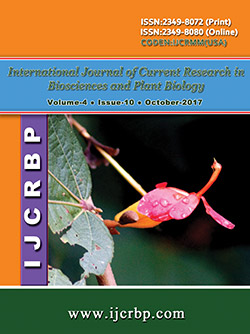 |
Online ISSN : 2349-8080 Issues : 12 per year Publisher : Excellent Publishers Email : editorinchiefijcrbp@gmail.com |
2Animal Production Department, Faculty of Agriculture, Mansoura University, Mansoura, Dakahlia Governorate 35516, Egypt
This work was carried out on lactating goats to investigate the effect of replacing concentrate feed mixture (CFM) protein by some types of silages on milk production, feed conversion efficiency and some metabolic parameters as well as economic efficiency. Twenty eight dairy Zaraibi goats were divided into 4 groups (7 does each). Treatments tested were 40% CFM + 60% maize silage (G1), 30% CFM + 70% mixture silage (50% maize + 50% sesbania) (G2), 30% CFM +70% mixture silage (50% maize +50% kochia) (G3) and 30% CFM +70% mixture silage (50% sesbania + 50% kochia) (G4). The feeding trails lasted 16 weeks. In addition, twelve adult Zaraibi males (each 3 males were fed one of the tested 4 diets) were used in digestion trails to evaluate the feeding values of the experimental rations. The obtained results showed that the contents of crude protein (CP), acid detergent fiber (ADF) and cellulose were decreased with maize silage compared with the other types of silage mixtures. Meanwhile, the highest values of ether extract (EE), nitrogen free extract (NFE) and hemicellulose were recorded with maize silage. The minerals analysis indicated also that Ca, Mg, K and Mn contents were higher, while Zn and Cu were markedly lower in maize silage than the three silage mixtures. The obtained data indicated that the digestion coefficients of all nutrients and DCP were decreased with control group (G1) compared with the three tested rations and differences were significant in DCP only. Ruminal pH values were not significantly affected by treatments. While ammonia–N and microbial protein concentrations tended to be higher with silage mixtures compared with control group and the differences were significant at 3 and 6 hrs post- feeding. Also, ruminal TVF,s concentrations post–feeding were significantly affected by tested rations and the highest values were recorded with G2. Concerning blood profile, the obtained data showed that the tested rations positively affected some hematological parameters such as Hb, RBC’s, MCHC and lymphocytes. Moreover, serum globulin, total protein and phosphorus were higher, while ALT activity was lower in all tested groups than the control group. As for milk production, the results indicated that the highest yield was recorded with G2 followed by G3 then G4, while the lowest with G1 and the differences were significant. It is interesting to note a negative relationship between SCC and milk yield. The effect of experimental rations on milk constituents and milk quality (pH and acidity) was not significant. Moreover, the feed conversion efficiency, based on DM and TDN, was better with the three tested rations compared with the control. In addition, the economic efficiency was noticeably higher by 33.73, 29.76 and 27.78with the three tested rations (G2, G3 and G4, respectively) compared with the control. Accordingly, it could be concluded that replacement of up to 10% of CFM-protein by some types of silage mixtures has some positive effect on metabolic parameters which reflected on dairy goat's performance and economic efficiency.
